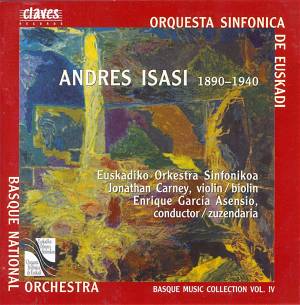Claves, the Swiss classical recording company, have
cornered the international marketplace for Basque classical music. To
the project they have brought exalted production standards and acute
artistic judgement. These place them in the select company of MD&G,
Sterling and Danacord.
The Claves' 'Basque Music Collection' reaches volume
4 with this Isasi disc. The scheme seems to be that each volume will
be dedicated to the music of a single composer. We started with Guridi
(CD-50-9709),
then came Usandizaga (CD-50-9814)
and then Arambarri
(CD-50-2001). I have only just caught up with the Isasi and Arambarri
anthologies. These are each ambitious projects in their own right. To
date there have been no chamber music, solo piano recitals or songs.
These orchestral discs would never have come into existence without
the funding of the Basque Government and the Mondragon Corporacion Cooperativa.
Isasi or, to give him his full name, Andrés Isasi y Linares was born in Bilbao on 28 October 1890 and grew up as nationalist influences were at their strongest. He saw how in 1906 and 1907 Guridi and Usandizaga were acclaimed after return from studies in Paris and Brussels and went to study with that ardent Wagnerite Humperdinck in Berlin. He returned to Bilbao in 1914. While his compatriots were making hay writing for the musical theatre he persisted in the same romantic orchestral music and style that he had evolved while in Germany. The public were not supportive. His Second Symphony was performed throughout Spain during 1915-19 but he found it increasingly difficult to make any headway in Spain.
Zharufa is sultry and unassumingly contoured. The textures are often pretty heavy, carrying the impress of Tchaikovsky rather than of impressionism. This piece would have gone well in Capriccio's Brises d'Orient series. Think about it as brother to Biarent's Contes d'Orient though not as highly coloured. Bantock is another brother across the seas as is clear from The Oracle.
Berceuse Tragica for violin and orchestra is a passionate yet sombre Havanaise of a piece. Dreamily expressionistic it is touched with the magic of Bruch and Korngold. In the Korngold parallel Carney takes the straitened and infinitely preferable way of Anima-Mathé (on Dorian - superb disc by the way) and Ulf Hoelscher (EMI Red Line) rather than the voluptuously raging excesses of Heifetz. Ardour rises from Carney's violin line with a radiant sheen; a lovely performance of a beautiful work.
The languidly romantic Erotic Poem takes its point of departure from Tchaikovsky especially Romeo and Juliet and the Fifth Symphony. This is a musical counterpart to the eroticism of an Alma-Tadema canvas rather than a Leon Bakst or an Egon Schiele. Much the same applies to Die Sünde (The Sin) which dreamily drifts in a lambently hazy glow related to Scriabin, Griffes' Peacock and Wagner's Siegfried Idyll. It lacks the melodic memorability of the Poem and at the end the performance seems to wheeze rather than exult.
Isasi's is a hyper-romanticism that touches on the same wellspings as those that enriched the music of Zemlinsky and Schreker. An even closer counterpart is Rudi Stephan (1887-1915) killed while serving in the German Imperial Army in Galicia. His Liebeszauber (1911) and Music for Orchestra (1913) are contemporary with the Isasi works and share a related mood-scene (Koch Schwann 3-6709-2). Isasi is not quite as 'advanced' as Stephan and he may have more in common with that other German war casualty Heinrich Bienstock (1894-1918). Another approximate parallel is Siegfried Wagner.
Outstanding documentation as usual. I have my fingers crossed that Claves will not overlook Guridi's Sinfonia Pirenaica if they ever do a Basque symphonies collection. An ideal coupling might well be Isasi's Second Symphony.
The performances are polished and in touch with the sometimes elusive and always expressionistically romantic music of this prophet who unjustly remained largely unhonoured in his own land.
Rob Barnett


